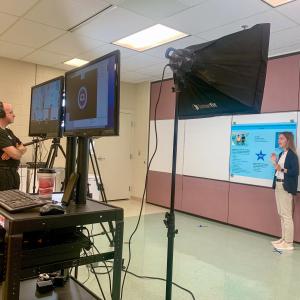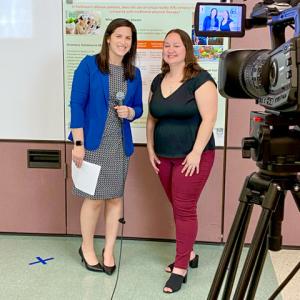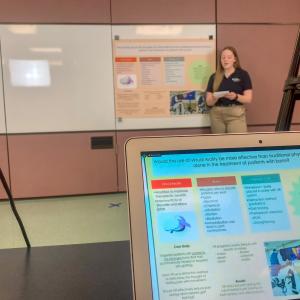PTA students present research via webinar
Published 05.03.2024
Photos provided by Victoria Hurwitz, physical therapist assistant director

Students in Penn College’s physical therapist assistant program recently presented research posters to members of the Northcentral District of the American Physical Therapy Association Pennsylvania Chapter.
Posters were created as part of the Rehabilitation course, taught by Autumn M. Breon, assistant professor of physical therapist assistant.
Students and their topics:
• Grace N. Allen, of South Williamsport: Does ultrasound or E-stim decrease symptoms more in patients with chronic low back pain?
• Emily M. Butler, of Cogan Station: In the geriatric population, does the use of Wii Rehab improve balance and coordination at a better rate than traditional interventions?
• Marianna Dariychuk, of Leola: What is the effect of aerobic exercise compared to conventional chest physiotherapy on pulmonary function and quality of life in patients with cystic fibrosis?
• Hannah E. Day, of Selinsgrove: For patients affected by a stroke, does aquatic therapy yield better outcomes than land-based physical therapy?
• Sonja M. Glucksman, of Montgomery: In Parkinson’s disease patients, does the use of virtual reality enhance balance and gait compared to traditional physical therapy?
• Corrin N. Evans, of Morrisdale: Would the use of virtual reality be more effective than traditional physical therapy alone in the treatment of patients with burns?
• Erica A. Hawbaker, of Huntingdon: In amputee patients with phantom limb pain, does mirror therapy improve pain in the residual limb more than physical therapy alone?
• Kerri R. Kauffman, of Millmont: Do children with cerebral palsy benefit more from robotic-assisted gait training than physical therapy?
• Jamie O. Krause, of Lititz: In patients with COPD, does respiratory muscle stretching in addition to normal aerobic exercise improve functional exercise capacity and thoracoabdominal kinematics?
• Dylan Marshall, of Jersey Shore: In patients with chronic low back pain, does aquatic therapy have better outcomes, compared to traditional therapy?
• Hayley M. Okronglis, of Kulpmont: In patients with Alzheimer's dementia, does cognitive behavioral therapy improve cognitive function and quality of life when compared to traditional physical therapy?
• Madison N. Racine, of Hamburg: For patients affected with rheumatoid arthritis, does aquatic therapy or traditional therapy provide better outcomes?
• Marlee M. Swank, of Elysburg: Do patients with vestibular disease benefit more with decreasing severity of symptoms from traditional vestibular rehab or virtual-reality-assisted rehab?
• Kade J. Wooten, of Allenwood: In patients diagnosed with a myocardial infarction, does the use of yoga therapy produce a better outcome compared to traditional therapy alone?
The students presented their research via a webinar, moderated by Victoria Hurwitz, director of physical therapist assistant, and facilitated by the Education and Emerging Technology Office’s Adam J. Miller, manager of instructional media production, and Michael J. Hersch, instructional development specialist.


